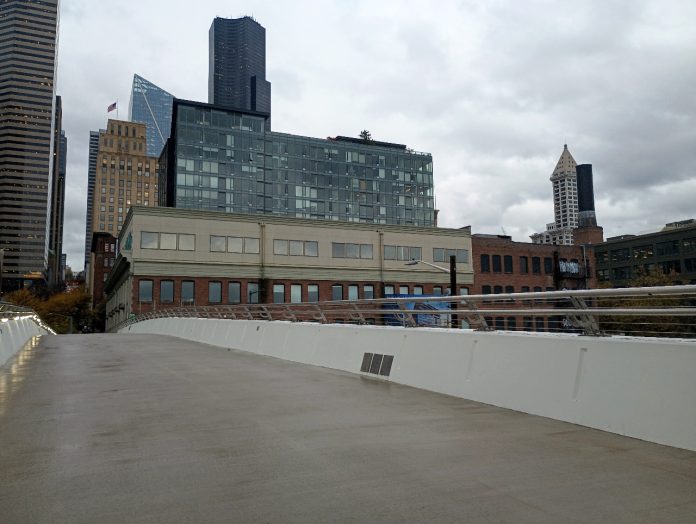
Late Friday afternoon, walk-on passengers heading to and from Colman Dock on Seattle’s waterfront were able to use a brand new pedestrian bridge directly connecting the terminal with First Avenue over Alaskan Way, a final element in the $489 million overhaul of the city’s flagship Washington State Ferries terminal. The new facility provides a wider walkway than the bridge it replaces, which was closed in 2019 in order to accommodate the demolition of the Alaskan Way Viaduct.
The City of Seattle and the Washington State Department of Transportation (WSDOT) jointly funded the $6.3 million cost for the bridge.
In order for the new bridge to open, the temporary pedestrian bridge, that has carried ferry riders along Western Avenue and Columbia Street, was closed in early November. But crews installing a ramp connecting the new structure with the exiting walkway between First Avenue and Western Avenue ran into more technical difficulties connecting the two structures than had previously been anticipated, delaying the opening by nearly a week.
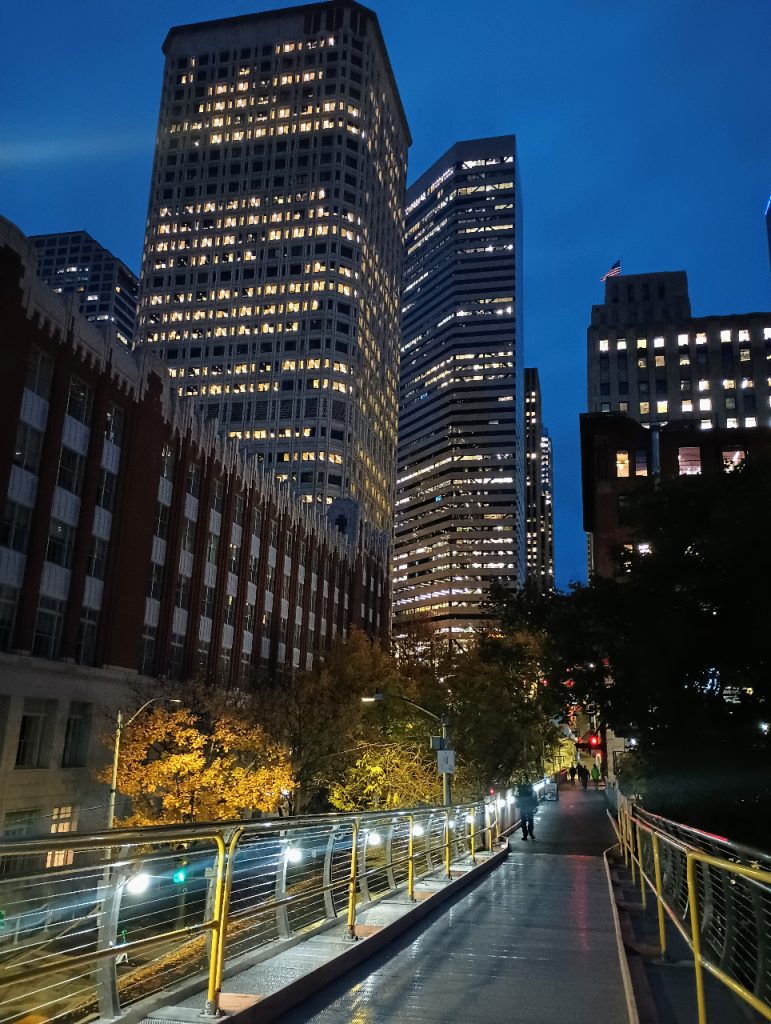
The new bridge joins a new 400-seat passenger terminal, a new entry building along Alaskan Way with a walkway connecting to the terminal above the car deck, and still under-construction public space being built outside the terminal’s front door as part of the waterfront promenade, as the major elements making up this generational overhaul of the state’s busiest ferry terminal, which provides vehicle and passenger service to Bremerton and Bainbridge Island, and passenger-only service to West Seattle, Vashon Island, Bremerton, Kingston, and Southworth.
In late October, Governor Jay Inslee joined WSDOT Secretary Roger Millar, County Executive Dow Constantine, and Seattle Mayor Bruce Harrell and other dignitaries in a low-key event commemorating the ferry terminal’s completion, before work had wrapped up on the new bridge.
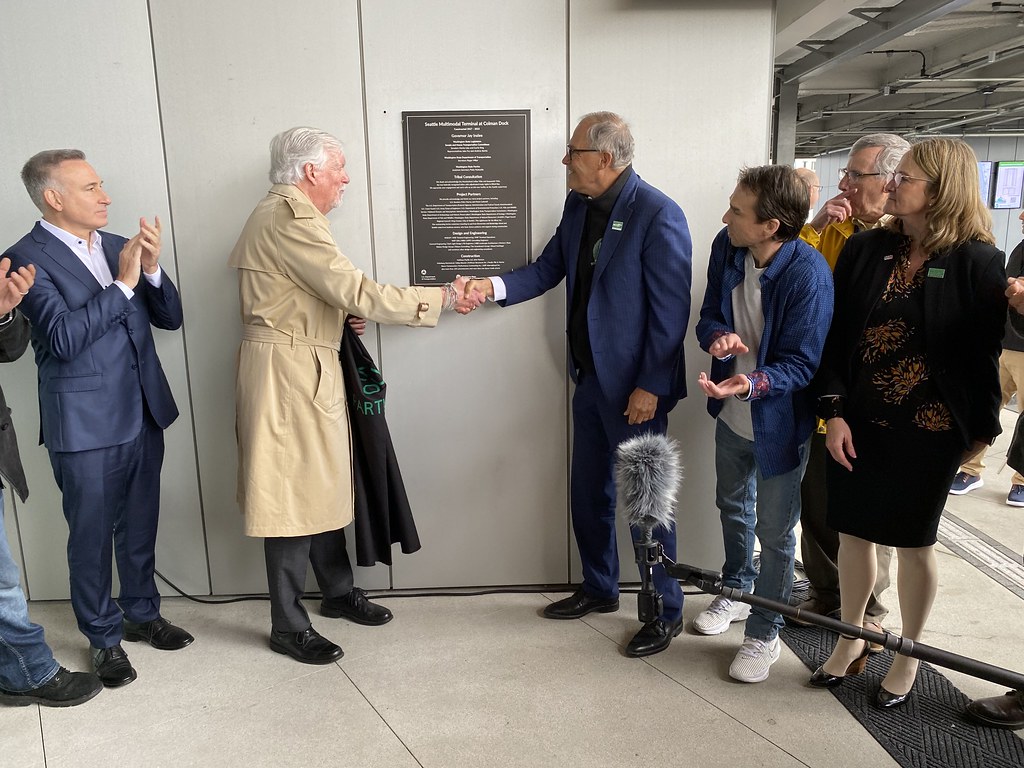
At no point during the six-year construction period did the ferry terminal shut down operations, and pedestrian access to First Avenue was maintained close to continually through that period via a temporary bridge that jogged over to Columbia Street via Western Avenue. Millar touted the partnerships with entities like the City of Seattle that allowed the major revamp of the terminal to happen.
“We’ve really built a new beacon here on the waterfront,” WSDOT Secretary Roger Millar said. “It’s built to serve 10 million passengers a year, and it was built while serving 10 million passengers a year.”
A multimodal hub
For over a decade, the chance to turn Colman Dock into a “multimodal hub” given the planned bike facilities, RapidRide lines, and ferry connections that converge in south Downtown has been a central element of Seattle’s waterfront redevelopment, even as many transportation advocates questioned the allocation of space along the new Alaskan Way, which includes curbside parking as one of nine lanes from curb to curb.
“Whether it’s our ports that bring and ship goods to and from around the world, or whether we’re transporting commuters throughout the region, investing in our waterway system is clearly key to our success as as city, and indeed our state,” Mayor Bruce Harrell said at October’s celebration. “Through this multimodal transportation hub, we are improving transportation travel experiences for residents and visitors throughout our ferry system and strengthening connections.”
Ten retail and food stalls are waiting to be filled at Colman Dock, and work continues to finish two pedestrian plazas along the outside of the building: sluʔwił (little canoe channel), named by the Muckleshoot Indian Tribe, and ʔulułali (place of traveling by water), named by the Suquamish Tribe.
With the new Marion Street bridge, pedestrian and bike access to the new terminal will be dramatically improved, with passengers heading to either the Washington State Ferry terminal or the King County-operated passenger ferry terminal able to use the bridge to bypass traffic at ground level, with elevator and stair access on either side of the facility.
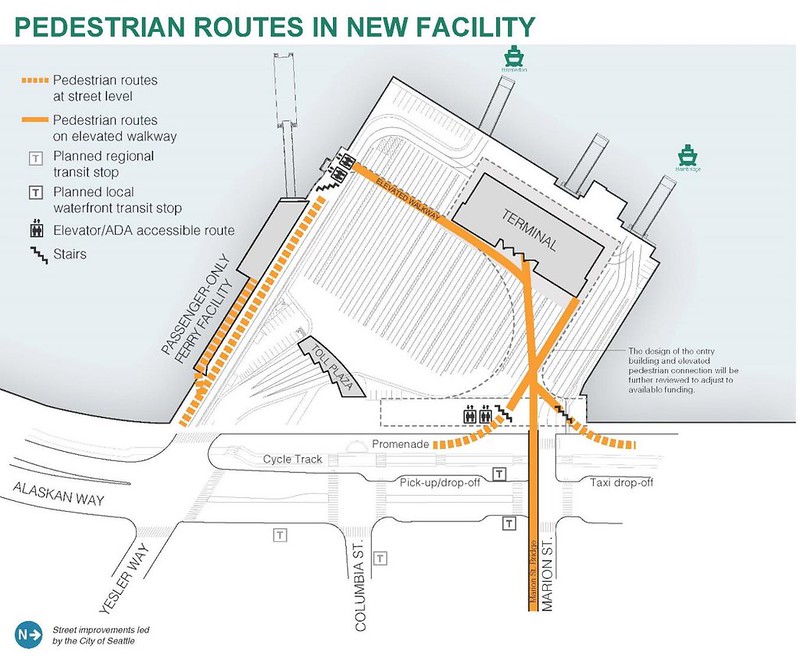
Due to the high cost associated with replacing the entire length of bridge all the way between First Avenue and Colman Dock, a pinch point remains at Western Avenue, though the new bridge will likely make a big impact for crowds leaving ferries with space provided for people to more easily disperse. But a future project to replace the remaining portion of the bridge has been envisioned by the City, though it likely wouldn’t become a major priority unless the condition of the bridge itself became a cause for concern or changes come to the Colman Building that the bridge is physically attached to.
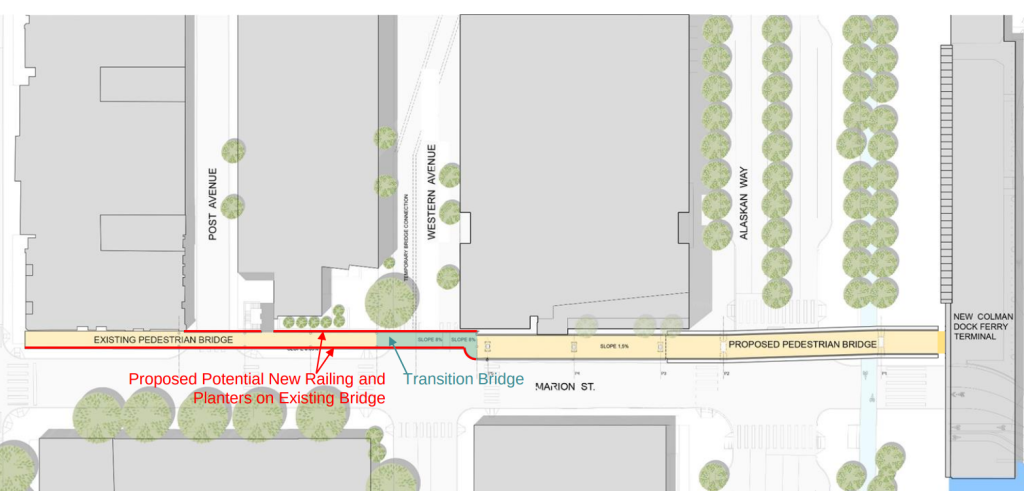
Due to that transition between old and new bridge, crews had to work to create a ramp over the past week connecting the two structures together. Temporary elements still remain in and around that final connection. Temporary lights along the bridge rails will be ultimately replaced with permanent fixtures. “As originally planned, some aspects of the bridge remain in a temporary condition as we continue to install railing, complete finishing touches and remove the temporary bridge columns,” Iris Picat, spokesperson for the City’s Office of the Waterfront confirmed Friday.
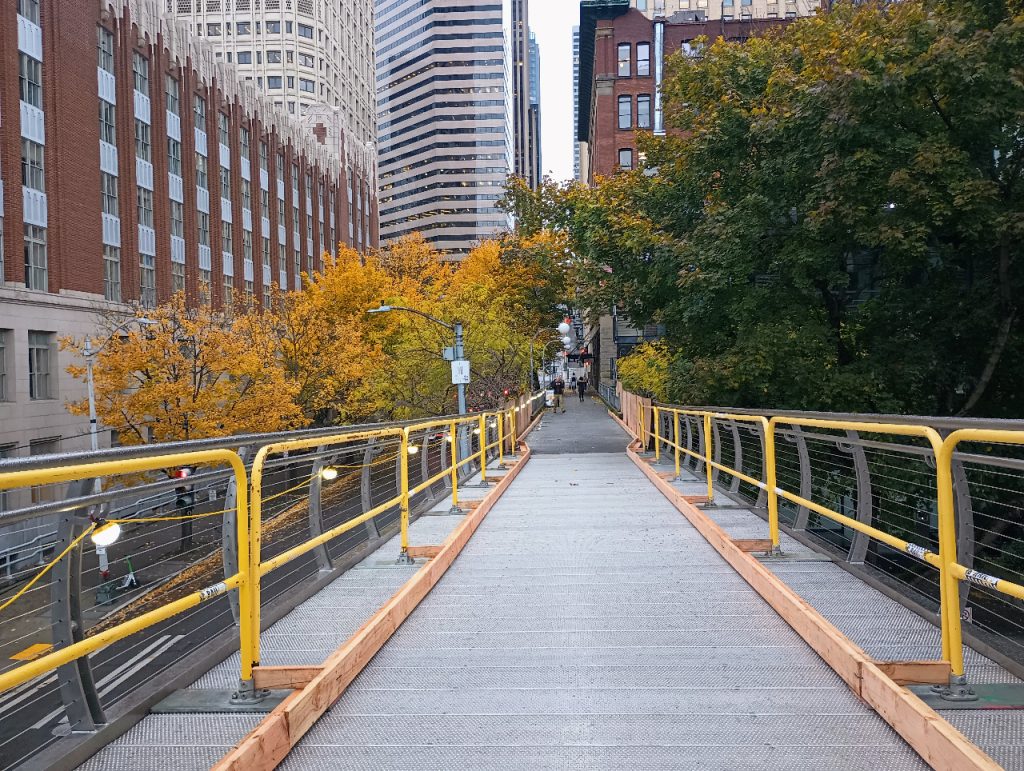
A new future for the old bridge(s)
The temporary pedestrian bridge that has been operating for more than four years, built on concrete supports via Western Avenue and Columbia Street, will see new life via an exciting new partnership announced last week. Thanks to coordination between the City of Seattle and the Puget Sound to Pacific Collaborative, five of eight of the spans of the temporary bridge are heading to Port Angeles for storage. Their final destination will be in Clallam County, where they will provide crucial connections as part of the planned 200-mile Puget Sound to Pacific Trail between Bainbridge Island and La Push.
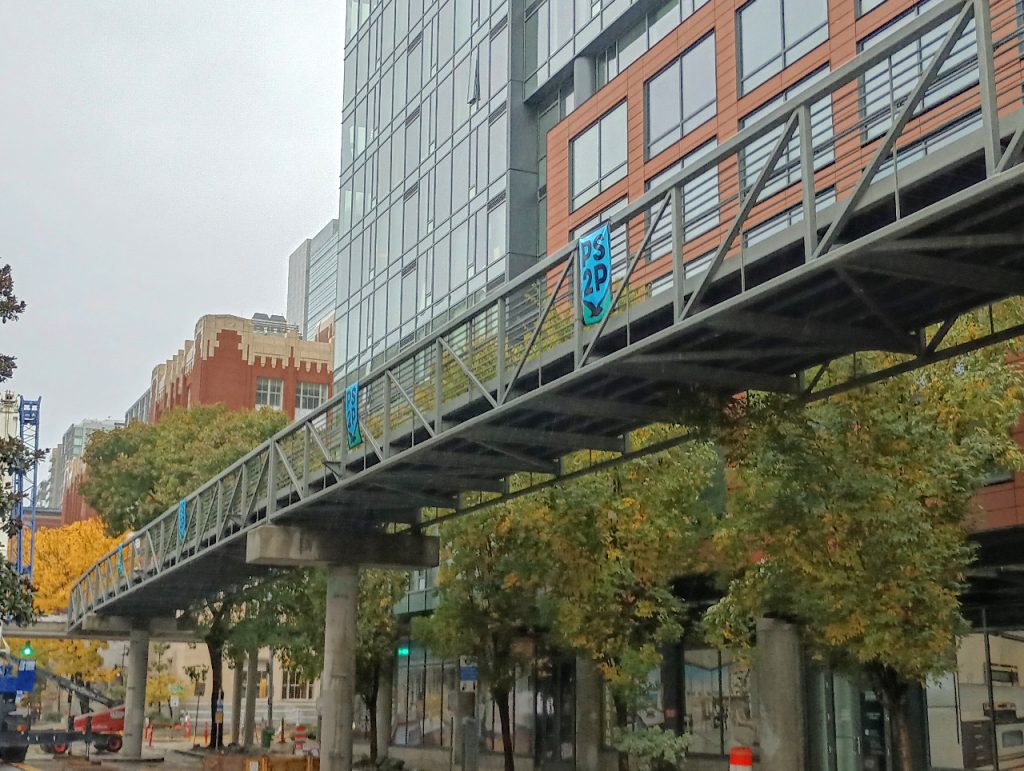
In June, The Urbanist reported that Port Angeles is set to administer a $16.1 million federal grant, shared with 12 other jurisdictions, that will allow planning and design work to proceed on multiple segments of the full trail envisioned as connecting Kitsap, Jefferson, and Clallam Counties, stitching together the existing Olympic Discovery Trail and the Sound to Olympics trail. Ultimately, the vision is a final western connection for the Great American Rail Trail which is planned to span more than 3,700 miles between Washington State and Washington DC.
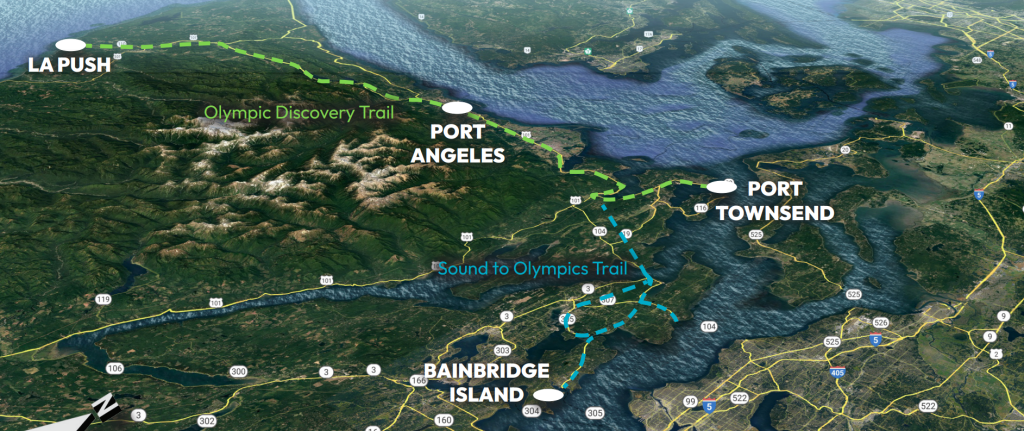
Colman Dock’s temporary pedestrian bridge will add more than 350 feet of needed connections along the western half of the planned multi-use trail, where missing trestles of the abandoned railroads pose costly challenges to trail construction.
“The walkway structures are great assets, and can see new use at a number of points along the Puget Sound to Pacific Trail,” said Mary Meier, Bainbridge Island Parks & Trails Foundation executive director. “We’re grateful to Seattle for making these available for public use elsewhere, as the new trail network builds out.”
The future home of the temporary bridges that were so useful to the city provides a great footnote to the story of the construction of Seattle’s permanent Marion Street bridge, which will prove an invaluable asset for getting people to and from the newly revamped waterfront.
With Colman Dock getting closer to its stature as the flagship terminal for the Puget Sound ferry fleet, Seattle has a new asset on the waterfront that visitors and residents alike will be using for years to come.
Ryan Packer has been writing for The Urbanist since 2015, and currently reports full-time as Contributing Editor. Their beats are transportation, land use, public space, traffic safety, and obscure community meetings. Packer has also reported for other regional outlets including BikePortland, Seattle Met, and PubliCola. They live in the Capitol Hill neighborhood of Seattle.

